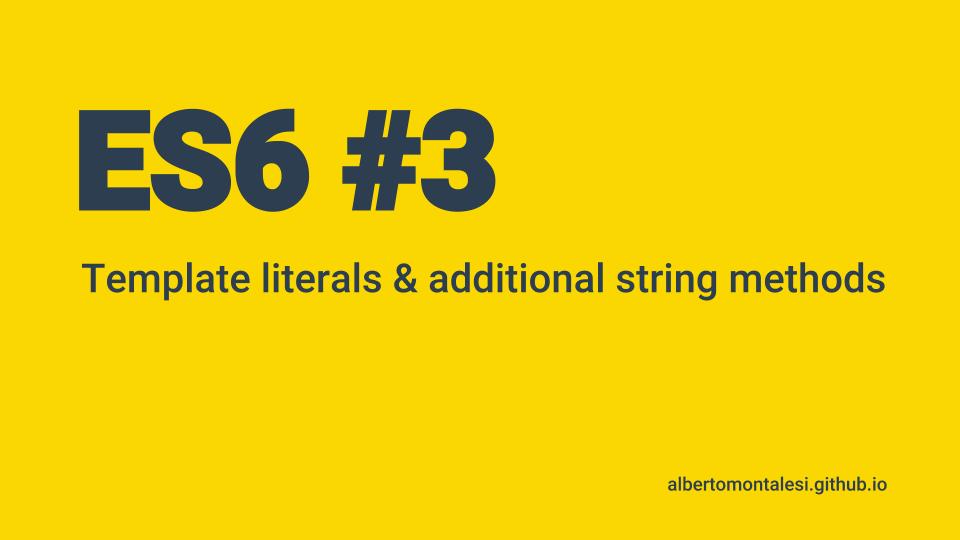JavaScript ES6 for Beginners #3: Template literals & additional string methods

Prior to ES6 they were called template strings, now we call them template literals. Let’s have a look at what changed in the way we interpolate strings in ES6.
Interpolating strings
In ES5 we used to write this, in order to interpolate strings:
var name = "Alberto";
var greeting = 'Hello my name is ' + name;
console.log(greeting);
// Hello my name is Alberto
In ES6 we can use backticks to make our life easier.
let name = "Alberto";
const greeting = `Hello my name is ${name}`;
console.log(greeting);
// Hello my name is Alberto
Expression interpolations
In ES5 we used to write this:
var a = 1;
var b = 10;
console.log('1 * 10 is ' + ( a * b));
// 1 * 10 is 10
In ES6 we can use backticks to reduce our typing:
var a = 1;
var b = 10;
console.log(`1 * 10 is ${a * b}`);
// 1 * 10 is 10
Create HTML fragments
In ES5 we used to do this to write multi-line strings:
// We have to include a backslash on each line
var text = "hello, \
my name is Alberto \
how are you?\ "
In ES6 we simply have to wrap everything inside backticks, no more backslashes on each line.
const content = `hello,
my name is Alberto
how are you?`;
Nesting templates
It’s very easy to nest a template inside another one, like this:
const markup = `
<ul>
${people.map(person => `<li> ${person.name}</li>`)}
</ul>
`;
Add a ternary operator
We can easily add some logic inside our template string by using a ternary operator:
// create an artist with name and age
const artist = {
name: "Bon Jovi",
age: 56,
};
// only if the artist object has a song property we then add it to our paragraph, otherwise we return nothing
const text = `
<div>
<p> ${artist.name} is ${artist.age} years old ${artist.song ? `and wrote the song ${artist.song}` : '' }
</p>
</div>
`
Pass a function inside a template literal
Similarly to the example above, if we want to, we can pass a function inside a template literal.
const groceries = {
meat: "pork chop",
veggie: "salad",
fruit: "apple",
others: ['mushrooms', 'instant noodles', 'instant soup'],
}
// this function will map each individual value of our groceries
function groceryList(others) {
return `
<p>
${others.map( other => ` <span> ${other}</span>`).join(' ')}
</p>
`;
}
// display all our groceries in a p tag, the last one will include all the one from the array **others**
const markup = `
<div>
<p> ${groceries.meat} </p>
<p> ${groceries.veggie} </p>
<p> ${groceries.fruit} </p>
<p>${groceryList(groceries.others)} </p>
<div>
`
Tagged template literals
By tagging a function to a template literal we can run the template literal through the function, providing it with everything that’s inside of the template.
The way it works is very simple: you just take the name of your function and put it in front of the template that you want to run it against.
let person = "Alberto";
let age = 25;
function myTag(strings,personName,personAge){
let str = strings[1];
let ageStr;
personAge > 50 ? ageStr = "grandpa" : ageStr = "youngster";
return personName + str + ageStr;
}
let sentence = myTag`${person} is a ${age}`;
console.log(sentence);
// Alberto is a youngster
We captured the value of the variable age and used a ternary operator to decide what to print.
strings will take all the strings of our let sentence whilst the other parameters will hold the variables.
To learn more about use cases of template literals check out this article.
Additional string methods
We are going to cover 4 new strings method:
startsWith()endsWith()includes()repeat()
startsWith()
This new method will check if the string starts with the value we pass in:
const code = "ABCDEFG";
code.startsWith("ABB");
// false
code.startsWith("abc");
// false, startsWith is case sensitive
code.startsWith("ABC");
// true
We can pass an additional parameter, which is the starting point where the method will begin checking.
const code = "ABCDEFGHI"
code.startsWith("DEF",3);
// true, it will begin checking after 3 characters
endsWith()
Similarly to startsWith() this new method will check if the string ends with the value we pass in:
const code = "ABCDEF";
code.endsWith("DDD");
// false
code.endsWith("def");
// false, endsWith is case sensitive
code.endsWith("DEF");
// true
We can pass an additional parameter, which is the number of digits we want to consider when checking the ending.
const code = "ABCDEFGHI"
code.endsWith("EF", 6);
// true, 6 means that we consider only the first 6 values ABCDEF, and yes this string ends with EF therefore we get *true*
includes()
This method will check if our string includes the value we pass in.
const code = "ABCDEF"
code.includes("ABB");
// false
code.includes("abc");
// false, includes is case sensitive
code.includes("CDE");
// true
repeat()
As the name suggests, this new method will repeat what we pass in.
let hello = "Hi";
console.log(hello.repeat(10));
// "HiHiHiHiHiHiHiHiHiHi"
This was the third part of my ES6 for beginners course, check out the rest of them here.
You can also read this articles on medium, on my profile.
Thank you for reading.

Leave a Comment